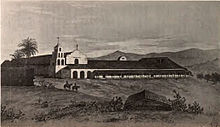re-contact
Settled by successive waves of arrivals during the last 10,000 years, California was one of the most culturally and linguistically diverse areas in pre-Columbian North America. Various estimates of the native population range from 100,000 to 300,000.[28] The Indigenous peoples of California included more than 70 distinct groups of Native Americans, ranging from large, settled populations living on the coast to groups in the interior. California groups also were diverse in their political organization with bands, tribes, villages, and on the resource-rich coasts, large chiefdoms, such as the Chumash, Pomo and Salinan. Trade, intermarriage and military alliances fostered many social and economic relationships among the diverse groups.16th, 17th and 18th centuries
Mission San Diego de Alcalá drawn as it was in 1848. Established in 1769, it was the first of the California Missions.
Despite the on-the-ground explorations of California in the 16th century, Rodríguez's idea of California as an island persisted. That depiction appeared on many European maps well into the 18th century.[31]
After the Portolà expedition of 1769–70, Spanish missionaries began setting up 21 California Missions on or near the coast of Alta (Upper) California, beginning in San Diego. During the same period, Spanish military forces built several forts (presidios) and three small towns (pueblos). Two of the pueblos grew into the cities of Los Angeles and San Jose. The Spanish colonization brought the genocide of the indigenous Californian peoples.

No comments:
Post a Comment